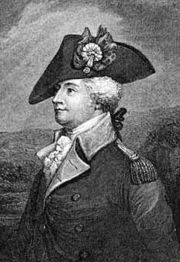
Anthony Wayne served nobly in the Continental Army during the American Revolution, and also in the indian wars on the western frontier during the 1790s. He died of complications from gout during a return trip to Pennsylvania from a military post in Detroit, and was buried at Fort Presque Isle, where the city of Erie, Pennsylvania, now stands. But his body wasn’t left in peace. His remains were disinterred by his family in 1809 and his bones were removed from the body. Most of him was reburied at Erie, but the bones were relocated to the family plot in St. David’s Episcopal Church Cemetery in Radnor, Delaware County, at the extreme other end of Pennsylvania. A legend says that many bones were lost along the roadway between those two places, and that once a year his ghost wanders the highway searching for his lost bones.
Sounds like a good beginning, eh? Well the rest of the story goes like this.
On November 19, 1796 General Wayne arrived, by boat, at Fort Presque Isle, now Erie, Pennsylvania, from Detroit. He was suffering from what has been described as “a severe fit of the gout.” He was taken to the quarters of the commander of the military post, Captain Russell Bissell, for medical treatment. General Wayne asked that Dr. J.C. Wallace, stationed at Pittsburgh 100 miles away, be summoned. But in the early hours of December 15, 1796, at the age of 51, General Wayne died. Dr. Wallace didn’t arrive in time to be of service. The General had requested that his burial take place two days after his death and that he be buried, wearing his uniform, in a plain wooden coffin at the foot of the flagstaff of the fort’s blockhouse. The top of the coffin was marked with his initials, his age and the year of his death in brass tacks.
The General’s body remained so buried for 12 years. In the fall of 1808, his daughter Margaretta, then seriously ill, asked her brother, 37 year old Colonel Isaac Wayne, to bring their father’s remains back to the family burial plot in Radnor, Pennsylvania. The following spring, Colonel Wayne made his way to Erie, traveling in a light two wheeled sulky. Erie, in Pennsylvania’s far northwest and Radnor in the far southeast are about as far apart as any two Pennsylvania towns can be. He enlisted the services of Dr. Wallace, the same man who had been summoned at his father’s final illness, to handle the arrangements of disinterring the remains.
Under Dr. Wallace’s supervision, the General’s coffin was dug up and opened. To the surprise of all, it was discovered that his body was still very much intact. It was in an excellent state of preservation with the exception on one leg and foot. It was quickly determined that the small cart Colonel Wayne had brought along was not large enough to carry the General’s remains. (One must wonder just what the Colonel thought he would be transporting.) Dr. Wallace thought on the matter and suggested to Colonel Wayne that the solution to the problem was to boil the body in water thus enabling him to separate the flesh from the bones. The bones could then be easily packed in boxes that would fit in the cart for the journey back to Radnor.
A large kettle was procured but it was still not large enough for a body. Thus poor General Wayne was cut into convenient pieces and dropped into the boiling water. As the flesh separated from the bones it was carved away by Dr. Wallace and his assistants who scraped the bones clean. The bones were then packed into several boxes. The liquid in the kettle, along with the flesh, knives and instruments used in the operation, were put back into the coffin, which was reburied in the original grave at Fort Presque Isle.
The boxes of bones were then loaded onto Isaac Wayne’s cart and the long journey back to southeastern Pennsylvania and the churchyard in Radnor began. Upon arrival they were interred in the burial ground of St. David’s Episcopal church on July 4, 1809. Some two years later, on June 5, 1811, the Pennsylvania State Society of the Cincinnati (a fellowship of officers of the Revolution) put a monument over the grave, which still stands although it is badly weathered.
To the credit of the General’s son Issac, he chose not to witness either the disinterment or the boiling down process. It is said that he always expressed regret over the decision to handle his father’s body in such a manner. Had he known of the state of preservation he would have preferred to have left the body in Erie and erect a monument there to his father’s memory.
The tale of Anthony Wayne’s two graves does not end with the flesh in one place and the bones in another. On November 10, 1853, the old abandoned blockhouse was set on fire by arsonists and burned to the ground. In later years the old parade ground was leveled off and the site of the grave was totally lost. In the 1870s a Dr. Germer, of Erie, investigated the location of the General’s original burial place. Once again some of the General’s remains were disturbed a second time. Dr. Germer discovered the lid of the coffin with the brass tacks giving the initials and date of death. Most of the rest had rotted away. In 1880, the Commonwealth of Pennsylvania rebuilt the blockhouse as a memorial to Anthony Wayne. The blockhouse has since been rebuilt several times, the last time in 1984. The original coffin lid was on display for many years.
The kettle which was used to boil the body of General Wayne is no longer known to exist. In the 1950’s, a kettle purported to be the one used to boil down the body was displayed by the Erie County Historical Society. In a more recent effort towards historical correctness, it was revealed that this was an invention to hype the society’s exhibits. The Historical Society claims to have no record of ever having the historic, if macrabre, Wayne kettle among its collections.
There is another strange footnote to this episode. Although one of the General’s feet and boot were much decomposed, the other boot was apparently like new, as was most of Wayne’s uniform. An onlooker by the name of James Duncan took the good boot, had a matching one made for himself, and proudly wore “General Wayne’s boots” for the rest of his life, or at least until they wore out.
So there you have it. Pretty strange tale, no? After a little research, the existence or non-existence of the actual kettle used seems to be a bit murky. So maybe there is still a little of this tale to be told.
